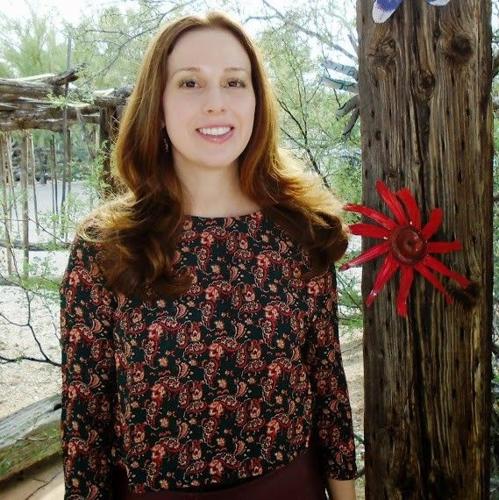As Lili DeBarbieri watched kids sled down New Mexican sand dunes in 2008, Daisy’s story crept into her mind for the first time.
She imagined a pocket mouse, lost in a sea of sand. In search of her burrow, the mouse encounters a hungry kit fox, a nonchalant lizard and a sand-sledding child.
It was the makings of DeBarbieri’s first children’s picture book “Sand Dune Daisy: A Pocket Mouse Tale.”
“I chose wildlife that was specific to the whole Southwest, and not New Mexico or Utah or anything too local,” DeBarbieri said, despite the book’s inspiration at White Sands National Monument in New Mexico. “I thought about what it would be like to put myself in the shoes of a little mouse lost in their environment.”
DeBarbieri, a Phildelphia native, has called Tucson home for nine years. A picture book on the natural world of the Southwest was only a matter of time.
DeBarbieri grew up around evergreens, not cacti. She had never seen a coyote before moving here.
“I think it’s just kind of a natural response to being in a different part of the country,” DeBarbieri said. “You become into all of these local things — the desert and surviving in the desert and what that means.”
DeBarbieri works as a program instructor out of Woods Memorial Library. As part of her day job, she visits Tucson Unified School District schools to teach students about the resources available to them at the libraries.
She never planned on becoming a writer, never studied journalism, never pursued creative writing.
Yet her portfolio includes three books on Arizona culture: “A Guide to Southern Arizona’s Historic Farms and Ranches: Rustic Southwest Retreats,” “Location Filming in Arizona: The Screen Legacy of the Grand Canyon State” and “Sedona Verde Valley Art: A History from Red Rocks to Plein-Air.”
She also freelances for a few local magazines, blogs for “Hobby Farms” and works as a Tucson stringer for Agence France-Presse, along with giving presentations on her areas of research, specifically film in Arizona.
“I wasn’t one of those people with any career goals to be honest,” DeBarbieri said. “I was interested in a lot of things, mostly travel, so I would try to do something and then I would kind of want to move on to something else. But that’s very much who I am.”
Writing, though, seems to be the interest that endures.
“It’s kind of a blueprint structure for exploring different interests, like movies or art or ecology,” she said.
Some of her experiences come together in “Sand Dune Daisy” — another travel experience at Mongolian sand dunes overseas, the weeks spent researching the social behaviors of prairie dogs in Utah, her high school love for writing fiction.
“I really enjoyed the stories of Beatrix Potter growing up, and I thought they were cute and fun and really reflected the animals in a nice way,” she said. “And you learned things and thought, ‘Oh, mice do that and kittens do that.’”
In one chapter of DeBarbieri’s life, she found herself working on a project watching prairie dogs for weeks. She grew to love the colony — and the fox that patiently waited each day to pick off a rodent.
Through that she found inspiration for the critters in her book.
“Watching nature in action was very special,” she said.
And that stood out to Mira Perrizo, the editorial director of Big Earth Publishing in Boulder, Colorado.
It fit the right criteria, Perrizo said. “We do books on the Southwest and we like books that are topical like this one, which is about the sand dunes of the Southwest. And, I thought it was a cute story.”
Because it was published through Big Earth Publishing company Westcliffe Publishers, it had to have a nonfiction component, Perrizo added.
“I wanted to do this book, so I had her stick in these little side notes,” she said.
So in addition to a glossary in the back, the book is full of wildlife facts.
The first copies with illustrations by M. Fred Barraza of New Mexico were published in December, after DeBarbieri spent years searching for a publisher.
“It’s, I guess, kind of like the character in the story,” DeBarbieri said. “It’s a lesson in perseverance and not giving up.”





